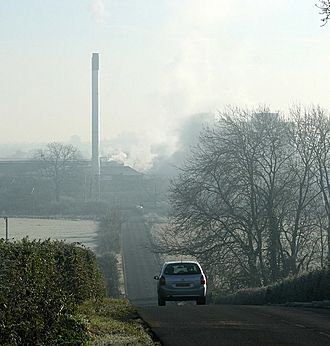Staverton Mill facts for kids
Quick facts for kids Staverton Mill |
|
|---|---|

The mill and chimney in 2007
|
|
| General information | |
| Location | Staverton, Wiltshire |
| Country | England |
| Coordinates | 51°20′49″N 2°12′22″W / 51.347°N 2.206°W |
Staverton Mill is a very old building in Staverton, a village near Trowbridge in Wiltshire, UK. It sits right by the River Avon. For a long time, it was a woolen mill, making cloth from wool. Today, it is a factory that makes breakfast cereals.
Contents
History of Staverton Mill
Early Days and Wool Production
People first mentioned a mill in Staverton way back in the 11th century. This was in the famous Domesday Book, a big survey of England. By the late 1300s, it had become a "fulling mill." This type of mill used water power to clean and thicken woollen cloth, which was very popular. A stone wall, called a weir, helped control the water flow to the mill's water wheels.
Around 1800, a man named John Jones bought the old mill. He tore down the original building and built the mill we see today. In July 1802, the new mill, then called the "Staverton Superfine Woollen Manufactory," faced some trouble. It was attacked during disagreements about worker pay. By 1813, Staverton Mill had 40 looms, which are machines used to weave cloth.
From Wool to Milk and Modern Changes
In 1897, the mill was sold to the Anglo-Swiss Condensed Milk Co. They wanted to make more condensed milk. To do this, they removed the top two floors of the mill building. The remaining parts became offices, a place for workers to eat, and storage areas. The new owners also updated the machinery. They replaced the old water wheel with a powerful water turbine. They also put in large copper vacuum pans and other equipment for making milk products.
The mill's old chimney from the 1800s was replaced in 1913. This happened when the boiler house, which made steam for the factory, was updated. A German company built the new brick chimney. It was very tall, standing 172 feet high, and cost £1,056 to build. Halfway up, there was a cast-iron water tank around the chimney.
The factory's products were sent by train from Holt Junction station. This station was about 1.5 miles away by road. In 1909, a large covered area was built at the station for loading goods. This loading bay was used until 1934. That's when the factory got its own direct connection to the railway line.
The Anglo-Swiss Condensed Milk Co. became Nestlé in December 1935. By 1936, local farmers were supplying a huge amount of milk to the mill. They sent over 5 million gallons of milk each year to be condensed. In 1935, a new building was added to the site to make things more efficient. The top four floors of the mill's original six were taken down. Just two years later, the number of workers had grown to 255 people. On a map from 1958, the site was called "Staverton Condenser."
Later 20th Century Developments
In 1967, a new factory was built on the site. This plant, known as the "baked bean factory," was for Crosse & Blackwell and cost £750,000. The milk canning factory closed in 1972. It was then changed into a plant for making yoghurt. This fit well with Nestlé buying the Chambourcy yoghurt brand in 1978. By 1980, the factory was making 72 million pots of yoghurt every year.
Nestlé made cans at the site for many years. These cans were for the milk plant and later for the bean factory. The bean factory produced cans of baked beans and pasta in sauce. They sold these under their own name and for other supermarket brands. The can-making part of the factory closed in 1989. It became cheaper to buy cans from another company called Metal Box. Nestlé stopped making most of its own cans after more than a century.
The brick chimney was a well-known landmark in the area for many years. However, it was taken down in 1989. A much taller metal chimney replaced it.
What is Staverton Mill Now?
The Crosse & Blackwell factory closed in 1995. The site was then taken over by Cereal Partners Worldwide. This company makes popular breakfast cereals. The Nestlé desserts factory also closed in 2004. In 2011, the tall metal chimney was removed. It was no longer needed for making cereal.
The site is also home to the main office of Trapeze Group UK. This company provides computer software for managing public transport.
Images for kids


